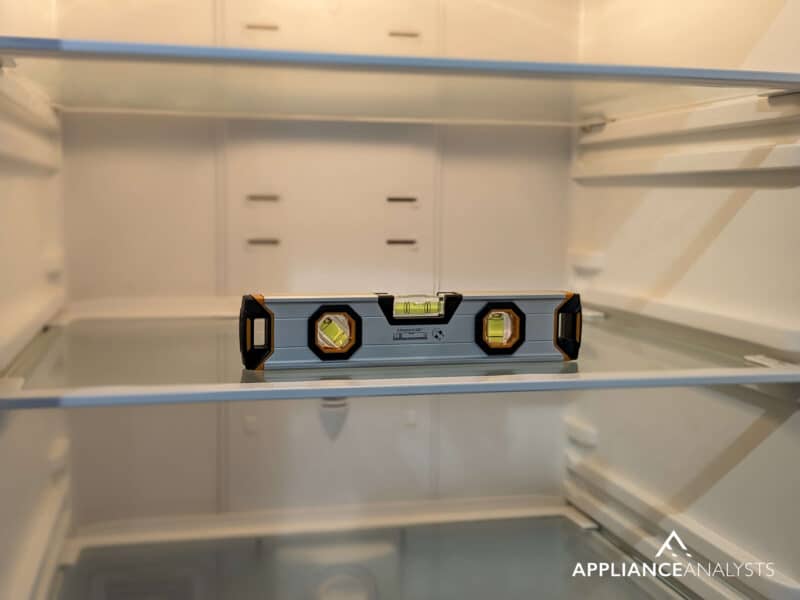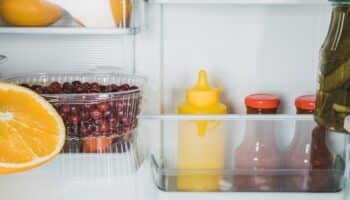We've independently reviewed this article to make sure it's as accurate as we can make it.
To find out more about our article creation and review process, check out our editorial guidelines.
Is your fridge leaking yellow liquid?
You’re not alone! Noticing a yellow liquid leaking from your refrigerator can be concerning.
But don’t worry; I’m here to help.
If yellow liquid leaks from your fridge, the drain pan is probably dirty or damaged, your fridge is unlevel, or the defrost drain pipe is clogged.
Read on to learn how to keep your fridge from leaking!
Why trust us? This article was written by Craig Anderson and Andy Fulenchek.
Craig has helped thousands of other homeowners repair their appliances since 2016.
Andy is one of our resident appliance repair experts with over a decade of experience. He currently runs his appliance repair company with a team of trusted technicians.
Fridge Leaking Yellow Liquid: 4 Simple Explanations
In this section, I’ll guide you through the different reasons that can explain why yellow liquid leaks from your fridge and provide various solutions.
Are you ready? Let’s dive in!
#1 External Problems
If you notice a yellow liquid leaking from your fridge, I first recommend considering possible external factors.
Before diving into any internal components, begin by checking all your fridge’s food containers. A broken container could explain why you have a leaking fridge.
Don’t forget to ensure there’s no water source nearby, like a leaking water dispenser, that could contribute to the puddle.
Note: It’s also important to clean the door seals and any spillages.
But if the leak persists, please check the drain pan. Read on to learn how to do it.
#2 Drain Pan Issues
When fixing a fridge that leaks yellow liquid, I always inspect the drain pan.
You see, the drain pan is meant to collect water draining from the freezer during the defrost cycle. Once in the pan, the water should evaporate. However, if there is a lot of dirt, debris, mold, or dead bugs in the pan, water can back up and eventually overflow.

Now you’re probably asking, “Why would the water be yellow?”
Well, the water can be yellow due to the accumulated gunk breaking down and mingling with the water.
The solution involves giving the drip pan a really tough cleaning and scrubbing. Just keep in mind that it won’t be a fun thing to do, as you can expect some foul smell possibly. If you’ve ever had to clean a drain for a sink, you understand how rancid that smell can be.
While you’re at it, please inspect the drain pan. If it’s cracked, water can leak onto the floor. In such cases, my usual advice is to replace the evaporator tray with a new one, typically costing around $30.
If you want to get any replacement part – or see how much one would cost – click to enter your model number in the search bar below. Our partners at AppliancePartsPros stock almost every part with free guides on how to install them.

Bear in mind that the drip pan should never overflow. It’s adequately sized to hold the water from the defrost cycle and allow it to evaporate throughout the day.
If the pan is not dirty but is overflowing, it could indicate a leak from the filter housing. In such cases, you’ll need to remove the kick panel and inspect the filter housing. If it’s leaking, please replace it. If you decide to call a professional, you can expect to pay around $250.
#3 Clogged Defrost Drain Pipe
I tend to find that when there’s yellow or orange liquid leaking from fridges, it’s typically due to a clogged defrost drain line.
Water from the defrost cycle drains to the pan through a defrost drain pipe. Unfortunately, if the drain pipe becomes clogged with debris or ice buildup, water can accumulate inside or in the bottom of your refrigerator or freezer.
To clear the clog, use hot water to flush it. Avoid using boiling water. You don’t want to trap boiling water in the pipe while the clog is still there, as it can damage the PVC. Continue to flush until the drain line is clear, and you should be good to go.
#4 Unlevel Refrigerator
If you’re still struggling with a yellow liquid, it’s time to ensure your fridge is level.
An unleveled refrigerator can cause the drain pan to fill unevenly. Yellow residue likely indicates areas where the pan has tilted due to the fridge’s uneven placement. Water tends to rush to these tilted spots as the pan fills, causing overflow in those particular directions.

So please ensure your fridge is level. Here’s how to do it:
- Place a spirit level on the base of the fridge and see if the bubble lands in the center.
- Open the doors at a 90º angle and remove the plastic kick plate at the bottom of your fridge.
- Locate the leveling legs or adjustable rollers (they’re located behind the grille).
- If your fridge has leveling legs, use a wrench to level it. But if your fridge has adjustable rollers, you’ll need a screwdriver instead.
- To raise your fridge, turn the wrench to the left. But, if you want to lower it, turn the wrench to the right.
- Keep making small adjustments and checking back in with the spirit level until that bubble is centered.
If you don’t get any more yellow fluid leaking on the floor, you know the drain pan is doing its job and allowing the water to evaporate efficiently now.
Click here to check out our refrigerator buyer’s guide to prevent any other leaks and make the most out of your appliance!
Wrapping Up: Fixing Yellow Fridge Leaks
Hopefully, now you know how to fix your fridge’s leak.
Remember that if there’s yellow liquid from your fridge, you’ll need to ensure the drip pan is clean and not damaged. Unclogging the defrost drain pipe and leveling your refrigerator is also important.
Thank you so much for reading. Please check out our other free guides if you found this post helpful.
Have a great day!








